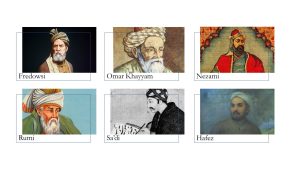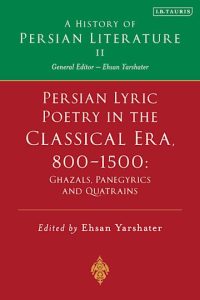A History of Persian Literature
Of all the literary and artistic accomplishments of the Persian civilization in its long history, by far the most significant and outstanding is Persian poetry. The jewels in the crown of Persian cultural achievements are the great classical Persian poets Ferdowsi, Omar Khayyam, Nezami, Rumi, Sa’di and Hafez.

Accordingly, much has been written on these and other great Persian poets, both in Iran and elsewhere. Sir William Jones (1746-1794) and Joseph von Hammer-Purgstall (1774-1856) were among the first scholars in the West to introduce the public to extensive specimens of Persian poetry through their translations and commentaries. The first systematic survey of Persian poetry, however, appeared in 1904 by the German scholar Hermann Ethé in Grundriss der iranischen Philologie II.
 Another milestone was A Literary History of Persia, published in four volumes between 1902 and 1924 by the erudite scholar E.G. Browne, Cambridge professor of Arabic and Persian. In 1956, the Czech Iranist Jan Rypka and his colleagues published the comprehensive History of Iranian Literature. Also worthy of mention in this context is the 1960 joint venture by Alessandro Bausani and Antonino Pagliaro, Storia della letteratura persiana, a highly suggestive study benefiting from the authors’ familiarity with world literature in general.
Another milestone was A Literary History of Persia, published in four volumes between 1902 and 1924 by the erudite scholar E.G. Browne, Cambridge professor of Arabic and Persian. In 1956, the Czech Iranist Jan Rypka and his colleagues published the comprehensive History of Iranian Literature. Also worthy of mention in this context is the 1960 joint venture by Alessandro Bausani and Antonino Pagliaro, Storia della letteratura persiana, a highly suggestive study benefiting from the authors’ familiarity with world literature in general.
A number of pioneering works also appeared in Iran itself in the course of the 20th century. These include Badi’-al-Zaman Foruzanfar’s Sokhan va sokhanvaran (On Poetry and Poets, 1929-1933), Mohammad-Taqi Bahar’s Sabk-shenasi (Varieties of Style in Persian Prose) in three volumes (1942) and a number of monographs on individual poets and writers. The most detailed treatment of the subject in Persian is Dhabih-Allah Safa’s Tarikh-e adabiyyat dar Iran (Literary History of Iran) in five volumes and eight parts (1953-1979). It studies Persian poetry and prose in the context of their political, social, religious, and cultural background, from the rise of Islam to the 18th century.
Nevertheless, it cannot be said that Persian literature has received the attention it deserves, and the works of the multitude of poets who have written in Persian in Iran, Afghanistan, Tajikistan and, in particular, in the Indian subcontinent and Anatolia, have remained understudied.
A History of Persian Literature contributes to the broadening of the literary, artistic, and intellectual horizons of its readership and brings to the fore the account of an extremely rich literature with a longstanding tradition that differs from Western literature in important ways.
The Significance of Persian Literature
The significance of Persian literature can also be gauged from its impact on some of the major European and American literary figures, such as Goethe, Matthew Arnold, and Emerson, to name only a few. E. M. Forster, the British novelist and critic, had this to say about Persian poetry when discussing English poetry: “Judged by its prose, English literature would not stand in the first rank. It is its poetry that raises it to the level of Greek, Persian or French.” Among the works that discuss the influence of Persian literature in the West, one may mention John D. Yohannan’s Persian Poetry in England and America: A Two Hundred Year History.
Judged by its prose, English literature would not stand in the first rank. It is its poetry that raises it to the level of Greek, Persian or French. – E. M. Forster
The demand for informative sources on Persian literature and the need for readable translations have assumed a new urgency in the context of developments that have taken place since the second half of the 20th century, with the growing interest in world literature in universities and elsewhere. The lone voices of a few perceptive earlier scholars like Sir William Jones, objecting to the kind of cultural parochialism that could see nothing of value beyond a knowledge of the classical literature of Greece and Rome, has now become a most powerful and persuasive chorus, and the dominant trend in most faculties of arts and humanities. In most campuses a far more vigorous attempt is being made to establish undergraduate courses encompassing literatures such as Chinese, Japanese, Indian, Arabic, and Persian.
 In this global context of cultural studies, Persian literature is a most fecund provider of thought-provoking texts dealing with metaphysical dilemmas in a creative, sophisticated and yet instantly appealing manner. Notice, for instance, the exceptional popularity of Dick Davis’ translations The Conference of the Birds (from a poem by Attar, 12th century) and The Legend of Seyavash (an episode from the Persian national epic, the Shahnameh, 10th century). The sheer range and richness of Persian poetry in different domains including mystical thought, ethical ideals and romances, and the wealth of the pertinent observations about human nature and its urbane speculations on wisdom both worldly and otherwise, couched in aesthetically superb lyrics, have ensured its growing popularity worldwide.
In this global context of cultural studies, Persian literature is a most fecund provider of thought-provoking texts dealing with metaphysical dilemmas in a creative, sophisticated and yet instantly appealing manner. Notice, for instance, the exceptional popularity of Dick Davis’ translations The Conference of the Birds (from a poem by Attar, 12th century) and The Legend of Seyavash (an episode from the Persian national epic, the Shahnameh, 10th century). The sheer range and richness of Persian poetry in different domains including mystical thought, ethical ideals and romances, and the wealth of the pertinent observations about human nature and its urbane speculations on wisdom both worldly and otherwise, couched in aesthetically superb lyrics, have ensured its growing popularity worldwide.
In short, Persian literature has a great deal to offer to students and general readers. A History of Persian Literature will provide a much-needed resource by offering a comprehensive survey, including the hitherto less-explored facets of this literature in different regions, as well as translations of specimens of both the poetry and the prose along with helpful commentaries. In the process, it will both inform and enlarge this international readership.

Scope and Duration
Of the 20 envisaged volumes of A History of Persian Literature, nine have been published (I, II, III, V, IX, X, XI and XVII, XVIII, 2009-2023). It is proposed to complete the project within 10 years.
VOLUME TITLES
I. General Introduction to Persian Literature (Ed. J.T.P. de Bruijn, 2009)
II. Persian Lyric Poetry in the Classical Era, 800-1500: Ghazal, Panegerics and Quatrains (Ed. Ehsan Yarshater, 2019)
III. Persian Narrative Poetry in the Classical Era, 800-1500: Romantic and Didactic Genres (Ed. Mohsen Ashtiany, 2023)
IV. Heroic Epic: The Shahnameh and Its Legacy
V. Persian Prose (Ed. Bo Utas, 2021)
VI. Religious and Mystical Literature
VII. Persian Poetry, 1500-1900: From the Safavids to the Dawn of the Constitutional Movement
VIII. Persian Poetry in the Indian Subcontinent: Divans, Biographical Anthologies and Literary Criticism
IX. Persian Literature from Outside Iran: The Indian Subcontinent, Anatolia, Central Asia, and in Judeo-Persian (Ed. John R. Perry, 2018)
X. Persian Historiography (Ed. Charles Melville, 2012)
XI. Literature of the Early Twentieth Century: From the Constitutional Period to Reza Shah (Ed. Ali-Asghar Seyed-Gohrab, 2015)
XII. Modern Persian Poetry, 1940 to the Present: Iran, Afghanistan, and Tajikistan
XIII. Modern Fiction and Drama
XIV. Biographies of the Poets and Writers of the Classical Period
XV. Biographies of the Poets and Writers of the Modern Period; Literary Terms
XVI. General Index
COMPANION VOLUMES TO A HISTORY OF PERSIAN LITERATURE
XVII. Companion Volume I: The Literature of Pre-Islamic Iran (Ed. Ronald E. Emmerick & Maria Macuch, 2009)
XVIII. Companion Volume II: Oral Literature of Iranian Languages: Kurdish, Pashto, Balochi, Ossetic, Persian and Tajik (Ed. Philip G. Kreyenbroek & Ulrich Marzolph, 2010)
ANTHOLOGIES
XIX. Anthology I: A Selection of Persian Poems in English Translation
XX. Anthology II: A Selection of Persian Prose in English Translation
